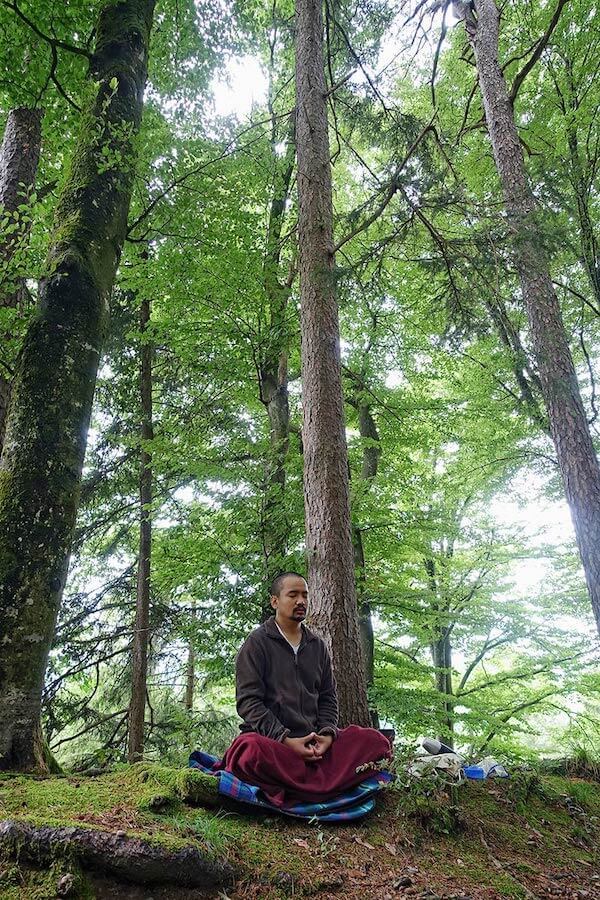The Shine practice
Focus and you’ll shine like a diamond
We have been practising Shine together over the past few weeks and have been getting into the different ways of doing this practice. Some of you are more comfortable meditating on a particular object with your eyes open, and some of you are more comfortable observing the breath with your eyes closed.
In the next few sessions we will practice how to pay attention to our thoughts. Some of you have already noticed that thoughts can be a major obstacle or impediment to what we would call “concentration meditation” or Shine. Thoughts are likely to arise in the form of questions, questions about the future, questions about the past, questions in the past and in the future.
So what to do with the thoughts?
From now on, instead of perceiving thoughts as an obstacle, you will turn them into an object of meditation, you will make them your friends. You will try to be more aware of your thoughts, you will try to observe them, you will say them out loud, you will record yourself expressing them out loud and you will take note of them.
An important issue to be aware of is whether someone has a psychological or psychiatric problem. However subtle it may be, it is important, even if it is a light form of depression. In this case, I advise you to try to solve these problems with the help of a professional and then to devote yourself to the practice of meditation.
I am not only referring to the practice of Shine, but also to any kind of meditative practice. Especially in the case of Shine, this is a practice that can go very deep and if you can’t handle what comes up afterwards, it might become too much for the practitioner. To begin the meditative practice you have to start from a good state of mental health.
Once you have the conditions for meditation, what do you do?
I want to share some advice in case anyone has felt that they are not doing well in their meditation and want to overcome that obstacle. The best advice I can give, which I also received from my Lama Rinpoche, from my Guru, Repa Tsultrim Tharchin, is to take refuge before starting the Shine practice.
Of course, you have to take refuge and cultivate bodhicitta. That way, at least, you can get the blessing of the Lama, of the Dharma, of the Buddha, of the Sangha.
Since the awakening of bodhicitta generates openness in your hearts, then you can do the practice for all sentient beings. Then you will not only be acting for yourself in a me-me-me way; but also for others, for children, for parents, for colleagues, for partners, for friends. This openness will help to establish a good state of meditation.
However, the most important thing that Lama Rinpoche said about this is “the act of connecting with the Guru”. Make that connection with the Guru by placing him above the head or perhaps in the heart, whichever is easier for you. Establish that connection before you begin the practice of Shine. At this time you call the Lama, you ask the Lama to give you the strength, to let go of everything, you ask for the blessing to do the practice, to be able to establish yourself in the state of meditation. You ask the Lama to guide you, you ask the Guru to support you. After connecting that way, you let it be as it is, you let it go. You can settle down like that, without expectations, without trying to do anything, without expecting anything.The Lama’s blessing is so powerful that when you get it, everything goes well. It doesn’t matter if it is Shine or any other sadhana or whatever you do. It is very important to connect with the Lama before you start any work, any project. Through this connection you will get the inner strength, stability and peace of mind to do anything.
This is one of the most important techniques I personally use. Before practising Shine, I take refuge. In that act I simply surrender and let go of the ego, the past, the future, my identity, the concept of knowing, of wanting to do a perfect Shine practice. There I stop all expectations.
Don’t put too much pressure on yourself, don’t force yourself, surrender in taking refuge. Let go of your worries, stress, anxieties, whatever appears in your mind, let it go. Just stay with the connection with the Lama in the taking of the ultimate Refuge and the bodhicitta, which you are realising for other people. Connect deeply with the Lama.
Then you will gradually enter meditation with the blessing of the Lama, the Buddha, the Dharma and Sangha and the Bodhicitta. Do not do any visualisation during the practice of Shine, only before you begin. Once you have acquired that strength, that blessing of the Lama, having that calmness, it will be easy to enter the state of meditation. I would say that this is one of the secret methods I received from my teacher, and today I wanted to share it with you.
Useful advice from experience
The second important point is an experience I also had as a beginner. In the early days of Shine practice with my Lama Rinpoche, he always emphasised quality over quantity. He often told me: – No, don’t make the meditation sessions too long. Practice for a short time, but with quality.
In the beginning I was very excited and wanted to do it for 1 hour, for 2 hours, for 3 hours, for 5 hours, but my Lama Rinpoche always emphasised that it is better to meditate for 5 or 10 minutes and then relax. He recommended that I open my eyes and then come back to go deeper and so on.
He emphasised that in the beginning the mind is like that of a small child. Like when you ask a child to do something, if he does it for a long time and gets bored or exhausted, then he will never want to do it again. So it is the same with meditation, meditate as long as you are enjoying it, and when the feeling is over, stop. Then the next time you will want to do it again. In this way, you will gradually awaken your interest instead of creating a feeling of frustration with your practice.
It is like when you do intensive yoga training and after a while your body is left resentful with a bad memory, you will not want to continue.
During very long sessions, your knees, back, spine, bones ache, your legs go numb, whether you do the full lotus or semi-lotus posture. At some point you may experience your head totally dull and ready to explode, your mind wandering and you will feel disturbing sensations. Perhaps your subconscious doesn’t like this activity so you may think, I won’t do it again, this will be the last time. Therefore, you have to generate enthusiasm and stimulate the practice in a joyful way.
My advice is that beginners start this Shine journey by doing short sessions several times a day. I suggest that to complete the 30 minutes a day, you do 10 minutes in the morning, afternoon and evening, or perhaps 15 minutes twice a day. If some of you are fine with the continuous 30 minutes, there is no problem doing it that way.
It is advisable to find a suitable posture in which your body and mind feel comfortable and you can meditate with joy. It is best to practice until you feel like “wow, I love it!”. Exactly like when you like some food very much, and you don’t overeat but eat it in the right measure. You know, meditate until you start to want to do it again and stop there. Don’t go too far, persistence and continuity is very important. I guarantee that if you start to love meditation, if it becomes an addiction, then it will be a lifelong practice.
The third point is the mindset with which we approach meditation practices. My Lama Rinpoche also emphasised this aspect when we practised Shine together. He would warn me: in meditation don’t strain, don’t wait, don’t force anything, just relax. Settle your body, relax your chest and don’t worry about how it should be or what state you want to achieve.
So, what is the mental attitude towards meditative practice?
I will illustrate it with a very clear example: what do you do when you go to the beach?
You arrive and you lie down and what happens then? You are just lying there, you are relaxed, you are not thinking about any projects, you are not thinking about when the holiday will be over, you are not thinking about the previous holiday, you are not thinking about stressful things. You are just laying there, with your body totally relaxed, the mind relaxes with every breeze: you are chilling out. This is exactly how your state of mind should be.
Another example would be when you go to bed to sleep at night. At that moment you don’t think: now I will have a deep sleep! You don’t expect anything, you don’t have the expectation that tonight I will get this or that kind of sleep. You just relax and fall asleep. This is how the attitude in meditation should also be.
However, there is a subtle difference between when you go to sleep or sunbathe and when you meditate. Usually when you sunbathe or go to sleep, you fall totally asleep. This is another hindrance in meditative practices and is sometimes due to physical and mental dullness and mental illness. Therefore, in meditation, initially the motivation to relax and the way to achieve this is the same as when you go sunbathing, but now you have to remain conscious. This means that the awareness of the body and the awareness of the mind are always there. The consciousness has awakened a little bit and is aware that it is aware. There is mindfulness in everything that happens at all times. On the other hand, when one goes to sleep there is no conscious state, there is no referent of anything, there is just this blackness.
Back to the practice of Shine, in the beginning being aware of the breath, of the bodily sensation will help you to maintain this awareness. So the breath can be an anchor, or the body sensation can be an anchor to maintain that conscious state.
As you open your eyes and look at a particular object, that object becomes an anchor for that conscious awareness, it will help you to maintain that conscious awareness at the same time that you need to maintain that total physical and mental relaxation like when you are sunbathing. That is the difference with the act of going to sleep.
So, in meditation you first need the relaxation of that day at the beach and then in the second step, you need to anchor the awareness to consciousness. That anchoring could be a particular external object, the sensation of the breath or the sensation of the physical body. That will help you to maintain awareness. This is very important and that is all for today.


